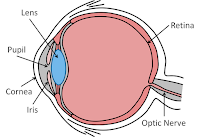"Much research on the basic science of vision asks what types of information the brain receives; this study instead asked how much. Using an intact retina from a guinea pig, the researchers recorded spikes of electrical impulses from ganglion cells using a miniature multi-electrode array. The investigators calculate that the human retina can transmit data at roughly 10 million bits per second."
"The retina is actually a piece of the brain that has grown into the eye and processes neural signals when it detects light. Ganglion cells carry information from the retina to the higher brain centers; other nerve cells within the retina perform the first stages of analysis of the visual world. The axons of the retinal ganglion cells, with the support of other types of cells, form the optic nerve and carry these signals to the brain."
As we've seen in previous posts, the impression we have of a highly detailed world don't come entirely from the eye, but also in a top-down fashion from in the form of predictive models from memory centers in the brain.








1 comment:
With how technology is developing, I sometimes wonder if in the future we may augment our vision with technology that will permit us to see more, better -- and how doing so might affect the human psyche, our experience of the world, etc. I think it's likely a matter of time.
In that case, you may have differences/clashes with people who see more, those who opt not to.
As an artist, would I accept that option? Perhaps, if I could selectively enable/disable it.
Post a Comment